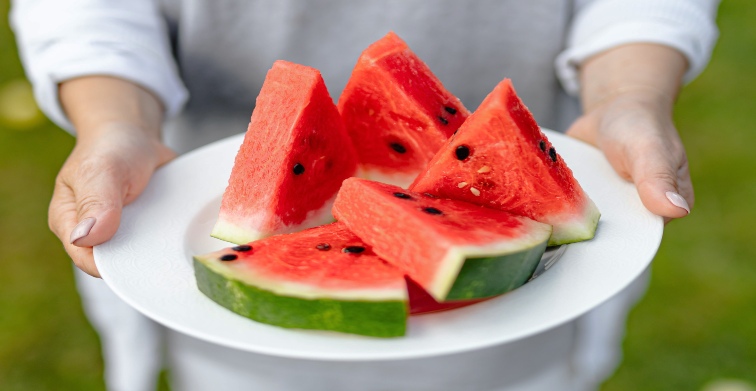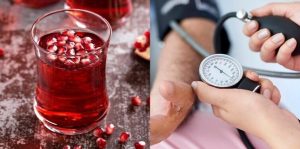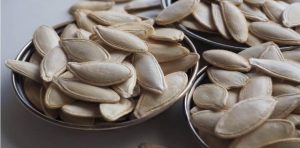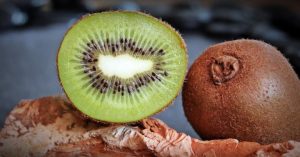Watermelon (Citrullus lanatus) is a favourite summer fruit for many people with its sweet taste and refreshing effect. The fruit is very rich in nutrients, and approximately 92% of it consists of water.
The red (or pink) colour of watermelon flesh is a sign of its high lycopene levels, which is an important antioxidant. The fruit also contains significant levels of vitamin C, vitamin A and some B vitamins {1, 2}.
In addition to lycopene, watermelon contains many other organic compounds known to help improve cardiovascular health, such as citrulline, arginine, ornithine, and nitrate.
This composition of nutrients makes watermelon a healthy choice for diets.
Studies showed that watermelon helps to lower blood pressure, especially with its citrulline, lycopene, and nitrate content. These organic compounds are known to help relax blood vessels and regulate cardiovascular functions.
The high potassium content of juicy watermelon is another reason the fruit is considered good for people with high blood pressure.
What is High Blood Pressure?
High blood pressure is an important public health problem as it can significantly increase the risk for cardiovascular diseases, including heart attack and stroke.
Blood pressure shows the force in the blood vessel walls against the blood flow through the body.
It is measured as 2 numbers; the first one (systolic blood pressure) shows the pressure against the heart pumps, and the second one (diastolic blood pressure) shows the pressure between the heartbeats (resting period).
Ideal blood pressure should be less than 120/80 mmHg. If it is higher, there might be a risk for cardiovascular diseases.
Eventually, if these numbers are consistently higher than 140/90 mmHg, it is diagnosed as high blood pressure, also called hypertension {3}.
How Does Watermelon Help Lower Blood Pressure?
Citrulline and nitrate are important molecules to improve vascular (blood vessel) health as both of these components of watermelon have a role in the production of nitric oxide, a molecule that plays a critical role in blood pressure regulation. Nitric oxide widens blood vessels and improves blood flow, and thus lowers blood pressure. This in turn reduces the risk of developing hypertension and other cardiovascular diseases {4}.
The question: how do nitrate and citrulline help to produce nitric oxide?
When dietary nitrate molecules are taken into the mouth, the special bacteria turn nitrate into nitrite. Nitrite molecules go directly through the stomach and are used to synthesize nitric oxide {4, 5, 6}.
As for citrulline; it is an essential source of nitric oxide. In the body, citrulline converts to another amino acid arginine, which is the precursor of nitric oxide {7, 8, 9}.
Research shows that the citrulline content of watermelon depends on environmental salt concentration (osmotic stress). It can be said that citrulline is a kind of defence mechanism for watermelon plants against high salt conditions. This molecule shows a similar effect in the human body too.
The citrulline content of watermelon was identified for the first time in a study conducted in the early 20th century. The following study also showed the ornithine and citrulline content of watermelon & watermelon seeds.
What is more, watermelon contains very high levels of lycopene. A 2022 meta-analysis, published in the Journal of Herbal Medicine, demonstrates the beneficial effects of lycopene intake on blood pressure levels.
Last but not least; watermelon contains a significant amount of potassium, 170 mg in 1 cup of diced (152 g) watermelon, according to the U.S Department of Agriculture.
Potassium helps to ease tension in the blood vessel walls, thus lowering blood pressure, indicates the American Heart Association.
Watermelon and Blood Pressure: What Does The Research Say?
To date, researchers have carried out several studies to evaluate watermelon’s effect on blood pressure. In these studies, several forms of watermelon fruit were used; including the fruit itself, extract, juice, powder, rind and seeds. The results were positive overall, suggesting that watermelon may help lower blood pressure.
Here are some of these studies:
In three different studies, the watermelon extract containing between 4-6 g of citrulline was used for 6 weeks. Both systolic blood pressure and diastolic blood pressure were significantly decreased in hypertensive and pre-hypertensive patients in each study {10, 11, 12}.
In a 2019 study, 2 cups of fresh watermelon consumption for 4 weeks significantly lowered the blood pressure and also body weight, oxidative stress and feeling of hunger in overweight and obese adults.
A study published in the Journal of Nutrition showed that watermelon juice consumption (500 mL for 2 weeks) increased blood flow in blood vessels and vessel relaxation after meals. Because it is known that acute high blood sugar due to meal consumption may reduce nitric oxide use in the body.
In another study though, watermelon juice intake (360 mL x 2 per day) for 4 weeks did not show a clinical effect on blood pressure, and it was mentioned the blood glucose level was slightly increased in these patients.
Do Watermelon Seeds Help Lower Blood Pressure?
In a recent study, healthy people were given the same calorie amount of watermelon seeds, watermelon rind or watermelon flesh (100 kcal), and the blood citrulline levels were investigated.
The citrulline level was higher in those who consumed the rind and flesh than those who received watermelon seeds. Even though arginine level was higher in the watermelon seeds than in the flesh and rind, the seeds didn’t increase the blood level of arginine.
Based on that it can be said that watermelon seeds are less effective than watermelon flesh when it comes to regulating blood pressure.
What Other Foods Help Lower Blood Pressure?
The Dietary Approaches to Stop Hypertension (DASH) is used to lower blood pressure since 1997. DASH diet includes fruits, vegetables, and low-fat dairy products and aims to reduce saturated and total fat intake.
The Mayo Clinic mentioned that the DASH diet contains foods naturally low in sodium and high in potassium, calcium and magnesium.
Exercise is also one of the most effective solutions to reduce high blood pressure. A meta-analysis study showed that aerobic exercises such as walking, swimming, biking, hiking, and dancing are effective to lower high blood pressure in hypertensive patients.
The info given above indicates that eating a healthy diet and doing regular exercise are two effective ways to keep blood pressure in a safe range.
In addition to watermelon; pistachios, pumpkin seeds and pomegranate juice can help lower blood pressure. Below you can read our articles to learn how these healthy foods achieve this.
Summary
- Watermelon is a healthy fruit with its high water and nutrient content. It has a low sodium level which makes watermelon a good choice for hypertensive patients.
- Watermelon is a natural source of citrulline, arginine, nitrate and lycopene, all of which are beneficial to maintaining cardiovascular health.
- Watermelon flesh and watermelon extracts appear to be more effective than watermelon juice and seeds in lowering blood pressure.
- It should be considered that high consumption of watermelon can increase blood sugar.
- Lowering sodium and saturated fat intake and increasing fruit and vegetable content are also important dietary approaches to lower blood pressure.
Sevginur Akdas is a Clinical Dietitian, currently pursuing her PhD on metabolism, chronic diseases and clinical nutrition.
Sevginur has many publications with dozens of citations as a part of a research team.
She is also a professional health writer. Using her professional knowledge and exceptional research skills, she participated in academic book chapters.
Moreover, Sevginur wrote articles monthly as a columnist for Popular Science Magazine from 2017 to 2019.
To view the studies Sevginur has been involved in, you can click the following links: ResearchGate -- Google Scholar
Click here to see her full bio.





